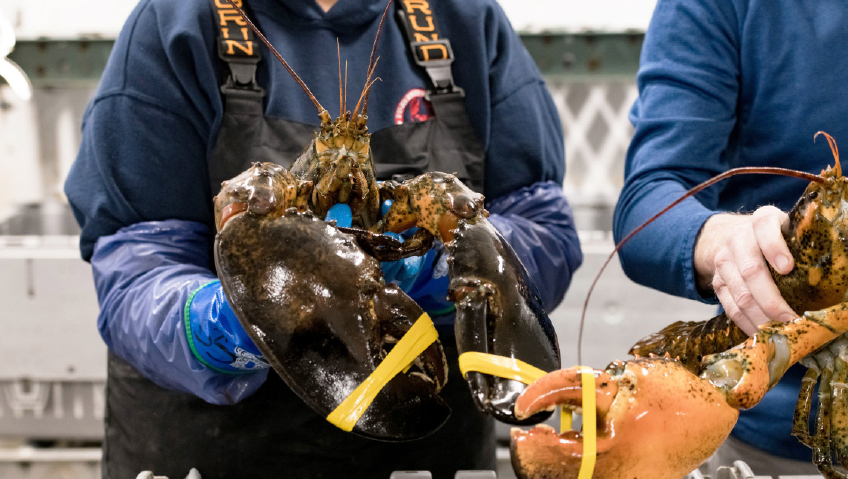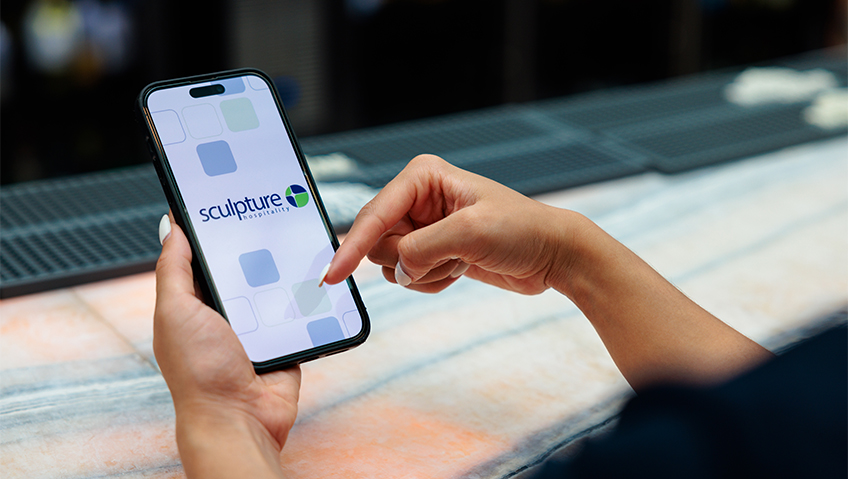Fishermen’s Premium Atlantic Lobster Inc., a leading exporter of live lobster based on Nova Scotia’s south shore since 2015, has now teamed up with New Brunswicker Ted ‘Lobster1’ Baxter, to expand its customer base…
In 2021, Canadian lobster exports (including both live and processed lobster) had the biggest year ever, topping $3.2 billion, $700 million higher than in 2019, when Statistics Canada valued the exports at $2.5 billion.
Live exports to the U.S., writes Paul Withers for CBC News, were valued at $522 million in 2021, up from $514 million in 2019, while exports of live lobsters to China at $454 million were down slightly from $457 million in 2019. Overall, lobster fishery is Canada’s most lucrative fishery, with the succulent crustaceans trapped off the coasts of New Brunswick, Prince Edward Island, Newfoundland, the Magdalen Islands, and the 13,000 km-long coastlines of Nova Scotia.
The richest lobster areas are in the cold Atlantic waters off the south shore of Nova Scotia, from Halifax to Digby in Zones 33 and 34, where Fisherman’s Premium Atlantic Lobster (FPAL) on Cape Sable Island is one of the richest areas of all. Annually, 1,662 licensed commercial fishermen bring in 26,195 metric tonnes during the six-month season, accounting for 60 percent of the lobsters landed in the Maritime Region. While that is admittedly a lot of lobster, the reassuring news is that, unlike the Northern Cod stock that collapsed in the early 1990s, Canadian scientists believe the lobster population remains healthy, in part because the industry is highly regulated. As a result, the population is increasing at a faster rate than the landings, according to a 2021 stock assessment, detailed by Kathy Johnson for Atlantic Fisherman.
While Cape Sable Island, connected to the mainland by a causeway, seems like an easy choice and obvious location to open a live lobster export business, there were challenges in the early days. FPAL’s community-minded President, Erica Smith, says the company, which formed in 2015, has roots going back to 2012, “a time when lobster prices plummeted to $3.50 per pound. The lobster fishery was the only industry in our area that could supply income to support a family, so the year the price dropped to $3.50 it was hard for fishermen to pay their gasoline bill, let alone their bait. It was a hard year for the entire community.”
“It’s always been a passion of mine since I was a teenager to have my own business and be independent. I always knew that one day I would have my own business. I remember my grade 12 year, the guidance counselor asked me what profession I wanted to go into after graduating, and I told him I wanted to start my own business but didn’t know what yet. He looked at me and said, ‘Well that’s nice,’ and never gave me any advice past that. That was the end of that meeting,” she laughs.
Smith started her career working as a Logistics Manager for a large seafood manufacturing / exporting company, where she worked for 12 years. “I learned a lot about the seafood industry working for that company,” she shares. “The seafood industry is different from any other industry in the world, with the regulations for health and safely, the fast pace environment, and with shipping and receiving,” she explains.
“When I ventured into starting a business, I was raising two small daughters,” Smith shares. “My daughter, Emily, was six at the time and my other daughter, Peyton, was five. The struggles, between raising a family and building a building, were real and very intense. I had many people around me at the time who thought I would fail, and a lot of people thought I was crazy for wanting to start what I did. My family has always come first above business, and to this day it still does. My daughters, who are now 15 and 14, are still my world, and to this day they are the two people on Earth who give me inspiration and motivation to do what I do in business,” says Smith.
In 2013, Smith says, “we incorporated Fishermen’s Premium Atlantic Lobster Inc. on paper, and started the planning process. There were three other men that helped me start the company. When we registered the company, I gave them some shares of the company’s equity. In 2015, there was a local plant located on Cape Sable Island that came up for sale. It had a small working area, two small tanks and a large outdoor tidal pound. The owner was wanting to retire and exit the business. No bank would even look at us at the time, but the owner gave credit terms to buy the plant and property directly from him. We set up a payment term with him, and that is how we got our start. Two payments of $60,000 per year to him for five years,” explains Smith.
“If it wasn’t for the previous plant owner, we would have never been buying lobsters. To raise capital, we held a fishermen’s meeting at the local hall. There were 80 local fishermen that came to that meeting. We sold preferred shares for $2000 each; we sold them all. The money we raised from the fishermen was put into working capital. Mind you, almost all of those shares have been paid back to the fishermen now,” she says.
“There were only eight fishermen, out of the 80 that invested with us, that sold their lobsters to us every day. Some of those eight fishermen went and sold to other places within the first year of FPAL starting out. Three fishermen have been with me since day one of my opening, and remain with me today,” says Smith.
Toward the end of 2016, the business moved from the community cooperative model to a corporate one, with Smith buying out one of the founding shareholders; she owns 50 percent of the business. In late 2016, she brought in a well-known industry leader who now owns the other half of FPAL. Together FPAL is jointly owned by Erica and her partner. “His role was to help FPAL with lobster supply and bringing the correct amount of capital to run the business. As well as, he makes a great sounding board for advice and support as the company has grown over the last six years.”
With the shift in 2016 with the new partner coming into FPAL, the company took a role in focusing on exporting lobsters. “We took our focus off of servicing the local boats to buying directly from our partner and other local companies,” explains Smith. “We developed strategic relationships with the local lobster buyers, which has worked very well for us.”
FPAL’s focus now is buying tractor trailers loads of lobsters at a time from its different partners throughout the Atlantic Provinces, Quebec, Newfoundland and New Brunswick. “As FPAL has developed our international customers, the company is exporting to China, Korea, the EU, Canada and the U.S.,” she says. Further growth is coming up for FPAL, with a lobster processing facility planned to open in November of this year which will enable the company to process and sell its own lobster meat.
Indeed, “We have experienced a lot of growth,” says Smith. “The first year I started we had gross revenue under $1 million, but since then we have seen as high as $45 million.” Six months into 2022, FPAL had seen $30 million in gross sales.
Smith has also increased the female office staff, which includes Natasha Brown, Office Manager; Kayla Atkinson, Financial Officer; Amber Messenger, Logistics Manager; and Laura Chen, Asian Sales Manager.
Natasha has been a member of the team for over a year now, and has grown quickly in the company under Smith’s guidance. “She started by filling in for a maternity position. We quickly realized she had much more potential and she became a big asset to the company. Currently she is tackling some sales, our marketing strategies, managing the office, dealing with human resource issues, and planning for upcoming expansion at the plant,” says Smith.
“Kayla has been with me almost since the start. She has maintained excellent financial records for me, while also keeping me up to date with everything I need to know. She drives us to put financials and budgeting at the highest importance in the company, and we owe a great deal of success to her,” Smith says.
“There are other companies in Nova Scotia who do what we do, but the unique thing we bring to the table is that we are a women-owned-and-operated export facility in an industry that is 99 percent male-dominated.”
Ted “Lobster1” Baxter
Ted Baxter, having just sold his mechanical company in Saint John, New Brunswick in 2016, was looking for another business opportunity. Having grown up in Shediac, New Brunswick, he saw many families in the seafood business that became very successful and was always a big follower of John Risley, Clearwater Seafoods’ cofounder. He was thinking of a clever way to get into the seafood business as he was starting later in life and most people in the industry were born into it. One afternoon at a MacDonald’s restaurant having coffee with a friend and brainstorming, they saw through GoDaddy that the domain lobster1.com was available.
Over the next year, Baxter studied the industry and saw that Southwest Nova Scotia was where most live lobster originated, exported throughout the world from the Halifax International Airport. He then convinced a gentleman in Barrington, Nova Scotia that he was going to buy his live lobster holding plant; they let him work on the docks when zone 34 opened late November. He rented a room weekly in the area, and when the weather was bad he would drive around to other holding facilities and talk to owners of other plants in Southwest Nova Scotia. He soon heard that a person in Cap-Pelé, New Brunswick had bought two live lobster plants in Nova Scotia. He cold called this person and convinced him he could sell his live lobster to the Asian and European market.
The rest is history. Over the next two years, Baxter was able to sell millions of pounds of live lobster to the Asian, European and U.S. markets, traveling to places like Changsha, Beijing, Shanghai, and Qingdao, in China; Brussels, Belgium; Barcelona, Spain; and Seoul and Busan in South Korea to build relationships with buyers at trade shows. Going by the name Ted “Lobster1” Baxter, he used such apps as LinkedIn (over 11,000 followers, the most in the seafood industry) and Instagram to gain followers for the Lobster1 brand, using communication apps such as WeChat (users name “livelobster1”) and WhatsApp to communicate with buyers in Asia and Europe. “This is a relationship business built through trust and communication,” he says.
It was Smith’s entrepreneurial spirit that drew Lobster1 to FPAL. He heard that they were looking for someone to push export sales, and knew of Smith’s reputation for aggressively growing sales at FPAL. After a couple of months spent convincing Smith he would be a great fit for her company, he was finally hired.
“She is a very determined individual,” he says. “This is a hustle business; you have to sell and get paid and buy more lobster. Using Lobster1 as a marketing tool has helped increase sales and Erica is an entrepreneur—a true one. With her lead, we are growing sales and we both enjoy the high you get from making the next sale. We work well together because she wants to sell, and I want to bring clients to her.”
The pandemic and airport closures in China have affected that market, at least temporarily; however, the South Korean, European, U.S. and Canadian markets have remained strong. As pandemic restrictions wane, importers from Italy visited the FPAL plant earlier this year, while Korean clients were set to arrive the week after our interview to see the entire operation for themselves, including a boat trip to see lobster traps hauled up from the ocean floor.
Exporting live lobsters
The six-month season in zones 33 and 34, where FPAL is located, opens at the end of November and when it closes at the end of May, lobster is brought in from Nova Scotia’s eastern shore and Cape Breton Island, Newfoundland, and the Magdalen Islands. There is also some coming from Prince Edward Island and New Brunswick, although much of the lobster from those provinces goes to local processors, where it’s frozen.
To carry out the work of grading and packing the lobsters, FPAL employs 25 to 30 local workers and an additional eight from the Philippines, who Smith calls “excellent workers. It was a struggle to find enough local workers in the beginning, but hiring Filipino staff was one of my better business decisions. I have good people, both Nova Scotian and Filipino, that I can say I love, and I treat them like family.”
When lobsters are brought into FPAL’s plant, they are graded and placed in holding tanks that meet strict protocols as set by the Nova Scotia Live Lobster Quality Certification Program, which include temperature controls and close monitoring for ammonia levels. Lobsters that appear too small or weak to withstand export are sold to local processors at a loss, which has led FPAL to establish its own processing plant, to open later in 2022.
“We have to make sure our lobsters meet the industry standard and that our product is of the utmost quality and to that end, we recently joined another program through the NS Fisheries Department, the Certified Marine Stewardship Council,” says Smith. This program ensures that members comply with internationally recognized standards, regarding traceability for wild caught fish through Chain of Custody Certification.
First, the lobsters are put into a purge tank where the water temperature is maintained at below 50°F, and where they remain for three or four days; then they go into a cool-down tank which is maintained at a temperature between 39 and 42° F, before being placed in 100-pound shipping crates.
“We put temperature recorders in each box and we track the shipments, which could be worth up to $200,000, and let the customer know exactly what time the shipment should arrive,” Smith explains. “Accompanying the shipment is a complete document package with files from government agencies, air cargo security, and FPAL. It is a very complicated and complex procedure, because we are shipping live animals, which is why there are so few exporters who do this well. There is just so much involved.”
Before export orders—which range from 70,000 to 100,000 pounds per week—can be filled, packers work through a complicated process to prepare them for what may be a 48-hour journey: four hours by refrigerated truck to Halifax’s airport, a flight to Toronto in a refrigerated cargo plane, and much longer flights to Asia, Europe or the U.S.
Community spirit
Knowing all too well how challenging the industry can be, FPAL has also provided financial backing, through loans, for young fishermen who didn’t have enough capital to buy a lobster fishing licence which, along with a fishing boat, can cost up to $1 million. “We want to come in as a partner to ensure they are successful, because their success is our success,” Smith shares.
In addition, FPAL also presents two annual scholarships of $2,500 each to female graduates from the local high school who plan to go into business—another way to ensure the local economy will continue to thrive. Indeed, while Erica Smith is focused on growing her business, she also wants to take on a role in philanthropy, using her success to support and empower more female entrepreneurs.






